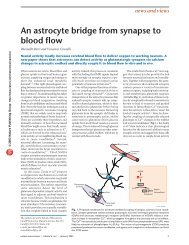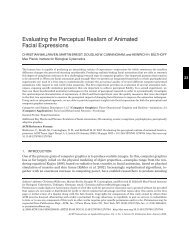Chapter 12: Centrioles
Chapter 12: Centrioles
Chapter 12: Centrioles
You also want an ePaper? Increase the reach of your titles
YUMPU automatically turns print PDFs into web optimized ePapers that Google loves.
CENTRIOLES<br />
In interphase cells, microtubules commonly radiate from the centrosome, and in<br />
dividing cells the microtubules of the mitotic spindle converge toward a diplosome<br />
at either pole of the division figure. The accompanying micrographs of dividing cells<br />
show numerous microtubules radiating from the immediate vicinity of a centriole. Such<br />
images have led to the assumption that the centrioles serve as nucleation sites for<br />
microtubule assembly. However, detailed studies of this region suggest that the<br />
microtubules do not actually contact the centrioles but end in a specialized pericentriolar<br />
zone of cytoplasmic matrix and are often associated with small dense bodies<br />
called centriolar satellites (indicated by arrows).<br />
Laser microbeam irradiation of acridine orange-treated living cells results in a<br />
disorganization of the pericentriolar material but causes no detectable alteration of the<br />
centrioles. This treatment disturbs formation of interpolar microtubules and interferes<br />
with anaphase movement of chromosomes. It is concluded that although centrioles may<br />
not be directly involved as sites of nucleation of microtubules, they may nevertheless<br />
contribute indirectly to spindle mechanics as agents of synthesis or organization of the<br />
pericentriolar material.<br />
Figures 307 and 308. Centriole regions irradiated with a laser microbeam without acridine orange<br />
sensitization. (Micrographs from Berns et al., J. Cell Biol. 72:351-367, 1977.)<br />
Figure 307, upper<br />
Figure 308, lower









